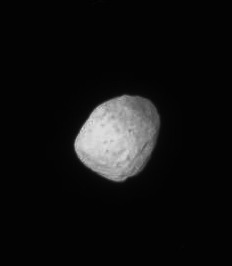New Raw images of Saturn's inner satellites

New on the raw images page is a sequence of images showing the shapes and geology of Saturn's inner small satellites: Pan, Atlas, Prometheus, Pandora, Epimetheus, and Janus. For many of these (except Epimetheus) these are the highest resolution images yet obtained for these small moons. Not much can be said for many of these moons. Pandora appears to be relatively young with only one crater visible in this view (though the polygonal shape may betray the presence of several, larger craters along the limb). Not much can be said for Pan and Atlas other than they appear to be oblong. Janus is most interesting in this view (shown above). The surface appears to be bright with number dark splotches on its surface. A crater to the upper right appears to have dark ejecta around it. Perhaps Janus is the opposite of Phoebe, with a bright surface layer with dark material beneath that is dug up by impacts.
The title link goes to a comparison showing all 6 moons side by side.


3 Comments:
I wouldn't say Pandora looks young here - the illumination is not conducive to seeing craters clearly. The best Voyager image shows lots of craters.
Phil
I agree. But the other views of Epimetheus and Janus seem to show more craters, at least in these views. But yes, in the Voyager views, a number of craters are discernable on Pandora. From this perspective I am almost reminded of Deimos. Maybe topography is muted on Pandora, not so much because of age, but because of an influx of fine material from the F ring.
It's interesting that you suggest an influx of material from the F ring. My analysis of Voyager's Prometheus and Pandora images some years ago suggested that Pandora was heavily cratered (as the best image showed), but that Prometheus had subdued topography. More like Deimos, as you say. I said at the time that Prometheus might be smoothed by deposition of material from the F ring, because dynamical studies at that time had showed that Prometheus occasionally brushed the F ring. And now we've seen that interaction actually happening.
Pandora is more distant than Prometheus from the F ring, so interaction would be less likely, presumably. But maybe things have been different in the past in this extraordinarily dynamic system. Anyway, it will be interesting to see what both Prometheus and Pandora look like in the best images later in the mission. I expect Pandora to look more cratered than you suggest, and Prometheus more like your interpretation of Pandora. But who knows? I have been wrong before. Not least when my entire images were consumed by jpeg artifacts!
Phil
Post a Comment
<< Home